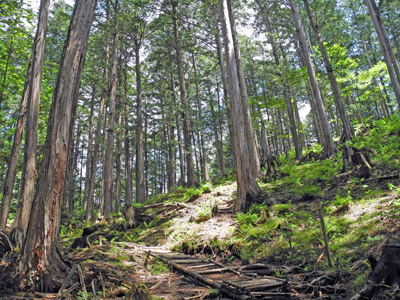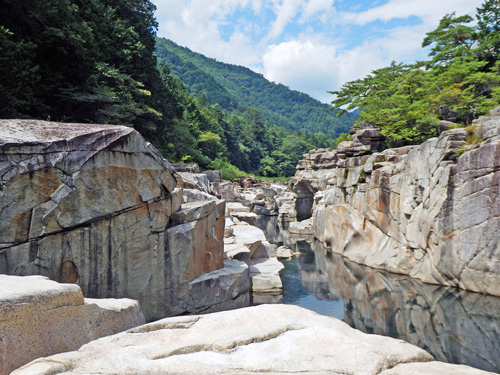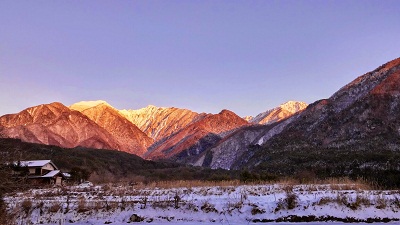
 |
|
The Akasawa [Ah-kah-sah-wa] Natural Recreation Forest is known as one of the three most beautiful forests in Japan. The forest offers eight scenic trails, most of which are suitable for all ages and one course being wheelchair accessible. Akasawa was the first forest in Japan to introduce the concept of “森林浴” [shinrin yoku – sheen-reen yoh-coo] or “forest bathing.” Bathing in this sense means walking the trails, enjoying the pristine views, and taking in the fresh air and aromas. It is believed that bathing in nature will bring about great physical and mental health benefits, cleansing body and mind. One of the main attractions of Akasawa is the forest railroad. During the height of the forestry industry in Kiso, several railroads connected the forests to transport lumber between them and to the towns. The last of these lines closed in 1970. To preserve Kiso’s history and offer tourists a new way to experience the park, the forest railroad was opened to tourists in 1985. Akasawa gives visitors the opportunity to experience one of Japan’s most pristine forests. Come visit and experience firsthand the wonders of forest bathing. |
.jpg)  |
 |
The story of Urashima Taro [Ooh-rah-she-mah Tah-roh], one of Japan’s oldest legends, has one of its footprints at the gorge. In the tale, Taro ventures to the Dragon King’s Palace undersea. What felt like days under the ocean was hundreds of years on land. In some tellings of the story, Taro ventured out on a journey after returning. According to local legend it was here at the Nezame gorge where Taro opened the Tamate Bako [tah-mah-teh bah-koh], an object somewhat similar to “Pandora’s Box”, which unleashed the hundreds of years of time that he was gone thus turning him into an old man. From this story the name “Nezame no Toko” was given, for “寝覚め--Nezame”, in Japanese means “to awaken” and “床—Toko”, means a “bed” or “place of rest.” In other words, “The awakening bed.” Nezame’s current appearance comes from hydroelectric activity that lowered the river’s water levels, revealing the magnificent granite boulders in their full majesty. The gorge’s outstanding vista garnered it a place on Japan’s official list of “Natural Places of Scenic Beauty”, one of seven in Nagano Prefecture. Take in the beautiful nature of Agematsu and see the mysteries that the Nezame no Toko Gorge has to offer. (*Visitors are permitted to climb the rocks, see the Urashima Taro Shrine, and experience the nature firsthand but are advised to do so with caution. Jumping from the rocks into the river is extremely dangerous and is strictly prohibited. Take your trash home with you. Please respect the nature during your visit to the gorge.) |
|
Mount Kisokoma [key-so-koh-mah] stands 2956 meters (9698 feet) tall and represents one of the main symbols of Agematsu. For many centuries, Mount Kisokoma has served as a prominent mountain pass in central Japan. The mountain acts as the highest peak in the Central Alps and there are many peaks situated nearby. The mountain offers excellent hikes for avid mountaineers and was awarded a spot on the “100 popular mountains of Japan.” A number of lodges sit atop the mountain for hikers wishing to spend the night. Awakening before dawn and watching the “ご来光” [goraiko – go-rye-koh], the brilliant sunrise from the top of the mountain, is highly recommended. Two courses are available for those hiking the mountain with both providing unique experiences and unforgettable views. Since Kisokoma is known as one of the more difficult hikes in Nagano, we recommend these courses for more experienced climbers. For the more casual hiker we recommend taking the Komagatake Ropeway located on the opposite side of the mountain in Komagane City. While at the top be sure to look for komakusa, the famous flower and symbol of the mountain. Whether you venture out and enjoy the trails or view the scenery from the town, be sure to take in Mount Kisokoma’s beauty while in Agematsu. |
 |
